by Dr. Sanjay Sane
Feet are the untiring workhorses of our body. With every mile we walk, 200,000 to 300,000 pounds
of stress bears down on our feet, and by the time we’re 50, most of us have walked 75,000 miles. That’s stupendous task for the two feet. And yet, most of us ignore them.
Structure of the foot
To understand the foot in a better way, it is necessary to know the foot structure and it’s functioning in brief.
The foot is a complex structure. It contains 26 bones, more than 30 small joints, and more than 100 muscles, tendons, ligaments, nerves and blood vessels. These must all work together so that your foot can do all that you need it to. Feet bear the whole bodyweight and take part in locomotion. They are responsible for distribution of the weight to the ground without causing any harmful effects to, itself and the joints of lower limbs. While babies feet generally all look similar, adult’s feet change over time with constant use.
Effects of aging
Feet age as the rest of our body does. Around our mid-40s, joints creak and joint tissues stiffen. Our feet begin to lose their once-plump cushion on the soles. This cushion is made up of fat pads, which are constructed to decrease the stress that walking puts on our bodies. Without those cushions, it can begin to feel like you’re walking on pebbles.
Our feet also change size from swelling due to fluid retention, loosening ligaments and the flattening effects of gravity and weight on the foot structure. In a country like India where there is a predisposition to flattened arches, (pronated feet i. e. feet that turn toward the inside of the arch) placing abnormal stress on the foot structure and muscles can
substantially add misery in feet with Rheumatoid arthritis.
Years of wearing the wrong or no footwear also take their toll. Problems can crep up like cracks and callosities, bunions, hammertoes or neuromas (an irritated nerve swelling often between the third and fourth toes)
Effects of Arthritis
As age advances, or with neglect, minor looking foot problems soon mutate to osteoarthritis (OA) in our feet. In fact, almost half of people in their 60s and 70s have arthritis affecting the foot or ankle.
Pain-whether it’s from arthritis or other foot problems changes the way we walk. And once we deviate from normal pattern of walking, it brings changes in the structural alignment and functioning our feet ankles, knees, hips and lower spine.
As an example, if you pronate and tilt your foot to the inside (simple terms flat foot), cartilage in the medial part of the ankle degenerates, causing you to pronate more, further wearing out the cartilage. This causes ankle to sink down forcing the shin bone to turn inwards putting stress on the knee joint. This leads to non-alignment of the knee, which can degeneration of outside of the knee joint. When the foot isn’t aligned, it affects everything – the way the knee, hip, pelvis or lower back is stressed in daily activities. And if stress is abnormal, it leads to problems in those joints, which may result in
deterioration of joint surfaces, or arthritis. If you already have disease like Rheumatoid arthritis, joint difficulties are pronounced and can be incapacitating.
Specific Foot Problems :
Inflammatory arthritis
The term ‘Inflammatory arthritis’ encompasses rheumatoid arthritis (RA), reactive arthritis, psoriasis arthritis and ankylosing spondylitis. The effect on the feet depends on exactly which type of arthritis you have. Rheumatoid arthritis, for instance, tends to affect many of the foot joints, while reactive arthritis usually affects only the ankle. People with
inflammatory arthritis can also have inflammation and discomfort in the tendons and the other ‘soft tissue’ structures in the feet. The part under the heel where the tendons attach to the heel bone is quite often affected in this way.
Gout
Gout is a particular type of arthritis caused by the formation of crystals in a joint. Gout often occurs in the foot, and the big toe joint is the most common site, but lesser toes may be affected. Gout causes a lot of inflammation, and the joint can be painful, red and hot while an attack lasts (typically 1-2 weeks) .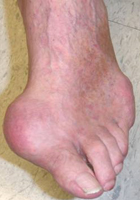
Without treatment, the attacks may
return and damage the joint and fluid will accumulate, eventually leading o permanent damage and osteoarthritis. Gout is usually controlled well with modern medications.
Problems in the ankles and heels.
Pain in the ankles and heels can arise either from the joints themselves or from the structures around the joint such as muscles and tendons. The joints can be affected by osteoarthritis or by inflammatory arthritis such as RA or reactive arthritis. Osteoarthritis is fairly uncommon in the ankle, unless there has been previous damage from an injury, or damage from long standing inflammatory arthritis.
When inflammatory arthritis affects the ankle, the joint may be especially sore or stiff when you first get out of bed in the morning, or after sitting for a while. With this type of arthritis the heel may drift outwards.
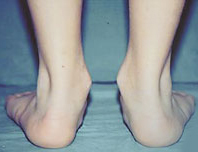
This so-called valgus heel is a common feature of RA. It can be bothersome if the arch also flattens as a result. Research has shown
that early treatment may slow the development of a valgus heel in people with RA. Supporting footwear and / or orthoses may help. A valgus heel can also be corrected with surgery.
Plantar fasciitis or heel bone spur
The most common cause of discomfort around the heel is inflammation in the ligaments that attach under the heel bone. You may hear this problem called plantar fasciitis. It used to be know as ‘policeman’s heel’. This is common with inflammatory arthritis, but can also occur in people without arthritis. If you can lose weight, this may help to ease symptoms in the heel. Treatment with oral medicines and modification in footwear or insoles may also help.
Painful arches ache and tired feet
The arches of the feet form a mechanism similar to the arch of old stone bridge, allowing the weight of the body to be spread evenly over many bones and joints and distribute the same to the ground. The arch structure can change with arthritis, and the structures nearby can be strained. In mild cases this feels like tiredness in the arch area, but pain and discomfort may develop if the muscles or tendons are very overworked. Losing some weight can help a lot, although this can be difficult to do if your feet hurt, because exercise becomes more difficult.
Swimming is good alternative form of exercise which you may be able to do instead of walking or other ‘weight-bearing’ exercises. If you have pain in the arches then non-steroidal anti-inflammatory drugs (NSAIDs), taken as tables may help. Arch supports or orthoses (functional orthoses) are very helpful for arch pain or tiredness.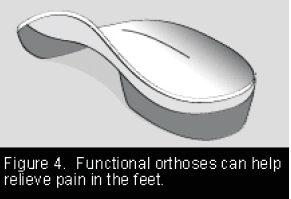
Bunions and bursae
Bunions are bony lumps that develop on the side of the foot at the base of the big toe. A fluid-filled sac under the skin (a bursa) may develop here too, especially if footwear is pressed against the bunion. The bursa may become inflamed and painful.
Sometimes, as the bunion develops, the big toe my be pushed over towards the smaller toes (this condition is know as hallux valgus). This can cause the other toes to become clawed, a condition known as hammer toes (see below). In RA a bunion
combined with clawing of the toes is common.
If a bunion forms the symptoms can be controlled. Choosing footwear with a soft upper will reduce pressure and rubbing on the bunion joint. If the bunion or the bursa does flare up then ‘bunion pads’ can be bought from the chemist. If the joint is continually painful over a long period of time, surgery may be needed.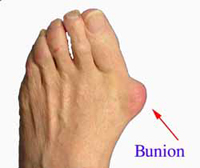
Claw toes or hammer toes
Hammer toes (also known as claw toes, mallet toes or retracted toes) occur when the toes are permanently bent. 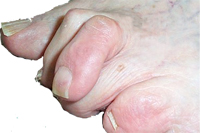
Hammer toes happen either because of problems with the tendons inside the foot, or because the toes are squashed by
poorly fitting shoes and/or socks. The most common cause of discomfort from hammer toes is a build-up of hard skin over the raised-up joints.
The only way to correct hammer toes is with surgery, although splints made of rubber, leather or silicone may help control mild cases. Any pain from corns and calluses may be eased by choosing shoes of a more generous fit, or with uppers made from soft materials. A protective pad over the area may also reduce the symptoms.
Painful ball of the foot
Pain can be caused by arthritis actually in the joints of the ball of the foot, especially if you already have arthritis elsewhere in your body. However most pain under the ball of the foot comes from minor damage to the soft tissues – the tendons, bursae, fat pads, nerves and skin.
Bursae are often found under the ball of the foot in people with RA.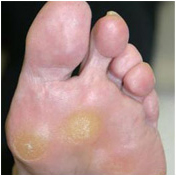
They also occur next to large bunions. Treatment for the inflamed bursa starts with reducing pressure on the area.
Rheumatoid Nodules.
In people with RA, rheumatoid nodules (firm,pea-sized lumps) can occur at sites of pressure such as the big toe joints, the back of the heels, or on the toes. Nodules occurring on the soles of the feet can be particularly uncomfortable. Padding can ease discomfort by cushioning the lumps. In some cases, surgical removal of the nodules may be needed.
Callus and corns.
Another common cause of discomfort under the ball of the foot is a build-up of hard skin (called callus) and/or corns. Callus forms at areas of high pressure or friction. If pressures are extremely high, small areas of skin within the callused area produce an abnormal type of skin tissue leading to the formation of a corn.
Treatment : Self help
If you are overweight, losing some weight can help ease the pressure on painful feet. Exercise is important in keeping joints moving, and the rest of the body healthy, but it may be necessary to change the type of exercise you take if your feet hurt. For example, swimming might be an alternative. If your ankles feel stiff in the morning, allowing some time for the joints to ‘loosen up’ will usually help. During the day, alternating sitting and standing activities helps to take the pressure off the feet.
Tips to help you keep your feet in good shape :
- Wash your feet every day in warm soapy water and dry them thoroughly, especially between the toes. A cotton wool bud soaked with medicated spirit or alcohol based like eu de cologne gently inserted between toes may help to keep area dry and free of fungal infection Dusting with medicated talcum powder is another option.
- Never apply surgical spirit if the skin is cracked or sore – wait a few days for the cracks to close.
- Check your feet every day for any problems.You can use a mirror if you have trouble bending down to inspect the foot. Minor cuts, abrasions or blisters should be covered with a clean dressing and kept dry. If they do not heal within 2-3 days then seek professional treatment.
- If your skin is dry, you can apply moisturizing cream. Don’t apply cream between your toes, though, as it tends to make the skin soggy. If you have difficulty bending down, use the top of one foot to massage cream into the sole of the other.
- Nails should be trimmed every 6-8 weeks.Cutting the nails straight across and using an emery board to file down the sharp edges reduces the chance of ‘in growing toenails’. You may find it easier to cut your nails after you have a bath when the nails are softer. Long-handled nail clippers are often easier to use than scissors, people on some medications (such as steroids), and people who heal slowly due to poor blood supply or have had problems with ulcers or vasculitis in the past. or are prone to infection, should seek professional advice first.
- If you have corns and calluses, you may be able to use an emery board or dry coarse cloth to keep them under control. You should never use an open blade such as a scalpel or razor blade. Special skin files and scrapers may be suitable as long as you and your skin are in good health. Over-the-counter creams and medicated corn plasters are not recommended generally, and people with vasculitis or people who heal slowly or have Diabetes should avoid these treatments altogether.
- Socks or stockings should be changed every day, and it is not good to wear them for prolonged time as it can become damp and soggy. Damp shoes are ideal conditions for growing bacteria and fungi. Removing footwear when sitting or resting will sufficiently air the skin and solve the problem.
- Athlete’s foot is an infection of the skin caused by a fungus. It is quite common in people with claw toes because the warm, damp area between the toes is an ideal environment for the fungus to grow. Athlete’s foot cause itching, and sometimes a speckled red rash on the skin. The athlete’s foot may disappear on its own if you are very thorough with washing and drying your feet, but a cream or powder from the chemist will speed things along.
Role of surgery
Joint replacements for the ankle and foot are not yet as successful as replacement of knees and hips.Most foot surgery is corrective surgery and is aimed at correcting the positions of the joints by resetting the bones or fusing the joint in the corrected position, or claw toe correction.
Pairing off calluses, excision of corns, and excision of warts may be required in some cases.If you are considering surgery, do discuss all of the available options with the surgeon before deciding whether to go ahead.
Steroid injections
If just one or two joints are inflamed and painful, a steroid injection may be recommended and given by the doctor, usually under a local anesthetic.
Footwear
Comfort and not fashion is the best pointer to the suitability of footwear. If the footwear protects your feet against injuries and keeps them warm, dry and comfortable, then it is doing its job. It also must protect and support the arch, or relieve high pressure areas from excessive walking strains. In patients with advanced deformities and pain, customized orthotic supports are necessary. A test called as Foot Pressure measurement or a foot scan is very helpful for the treating doctor and the footwear consultant to diagnosis the problem and design the footwear in a proper way.
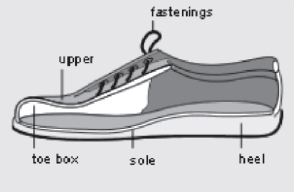
Upper
- Soft, flexible and ideally waterproof canvas or good quality genuine Leather and many modern synthetic materials are quite acceptable, though leather tends to be more breathable.
- A smooth lining without seams reduces irritation of hammer toes and prominent joints.
Toe box :-
- Should be deep enough to allow you to move our toes and be a similar shape to the natural shape of your feet.
Sole :-
- Strong and flexible for good grip.
- A cushioned sole may be more comfortable (trainers are sometimes ideal).
- A removable insole can be taken out to be cleaned, and is easily replaced when worn out.
Heel :-
- Takes much of the body weight.
- Needs a broad base for stability.
- Should be flat or with concealed heel.
Shoe Fastenings :-
- Provide a stable fit and some flexibility to allow for unusually shaped feet or swelling.
- Fastenings include laces, buckles, velcro.
- Slip-on shoes must be used carefully especially if feet are prone to swelling; they may fall off at the heel if bought lose or if they are tight may become a little too small to keep them on, cramping the toes.
Care while buying footwear
- Have your feet measured if they have become wider over the years, or have changed shape because of arthritis. Your feet may change shape when you stand up, so have them measured while standing. A good foot scan will immensely help in these patients.
- Try shopping for shoes later in the afternoon. If your feet tend to swell, this will be when they are at their largest.
- Size varies between shoe brands and style.Judge a shoe by how it feels on your foot and not just by the size marked on the shoe. Think about now the shoe fits around your toes, under the soles, and at the back of the heels.
- Many people have one foot bigger than the other. Always buy your shoes to fit the larger foot (an insole can be used in the other shoe.) There should be at least 1 cm (3/8 inch) of room at the front of the longest toe.
- Try shoes on with the type of socks or stockings you normally wear, or with any insoles or orthoses you normally wear with them. Some insoles many need extra depth, especially in the toe area.
- The right shoes for you will be comfortable when you first try them on.
- Soles should be light, hard-wearing and flexible. The sole should be able to bend along an imaginary line drawn from the base of the big toe to the base of the little toe.
- If you are worried about the appearance of your feet, dark colours and a suede finish will help to disguise the problem.
- When using new shoes, give some run is period of 7 days to get used to and then start wearing full time. Customised footwear
Some people may have feet that just cannot be fitted into shoes which are available on the high street. People with permanently swollen feet, very narrow, long, or very broad feet, or with hammer toes or bunions may find it difficult to find shoes that fit well. Some people may have footwear prescribed especially for them by their consultant of GP or orthotist. The shoes are usually provided by an orthotist.
Wearing ”Slippers” or ”sapatas” around the house.
Many people prefer to wear slipper in the house rather than prescribed footwear However, slippers are not a good idea for those who have to wear special insoles. In many patients the small muscles of the foot have lost capacity to hold the slipper in the space between the Great toe and first toe. The uppers of slippers are often soft and so are comfortable for hammer toes and prominent joints, but the outer soles lack adequate cushioning.
Slippers also sometimes cause falls in the elderly. Open sandals in another alternative. Backless slippers and slippers with a high heel really should be avoided.
Use of socks
Wearing thicker socks or two pairs (as long as they are not too tight) not only helps to keep the feet warm but also provides extra caushioning under the soles of the feet. Keeping the feet warm will also be easier if you keep the rest of your body warm. It has been scientifically proved that wearing socks can reduce the effect of high plantar pressures by 25%.
Prevention :
If you already have arthritis, have your feet checked by a specialist, or a podiatrist experienced with arthritis. Your doctor will foresee future potential problems, likely suggest X-rays, foot scan and prescribe a preventive treatment plan. Often people with rheumatiod arthritis will lose their arch, and need arch support. Patients with callosities, plantar inflamed bursae will require pressure relieving insoles. Another key to foot health is exercise. Stretching out the Achilles tendon (the cord at the back of the heel) and the tendons in the balls of your feet and toes can minimize stiffness and pain. A foot that doesn’t have mobility will invite abnormal stresses and pain.
If your feet continue to be sore, consider selfmassage, gentle kneading the foot and your toes top to bottom. Gentle heat and ultrasound, topical medications such as those containing capsaicin sometimes help to relieve pain. Arthritic feet are weakened feet and have to be cared for. They are like a glass pot liable to crack with slightest of trauma and good comfortable protective footwear will preserve the functionality and keep feet pain free for lifetime.
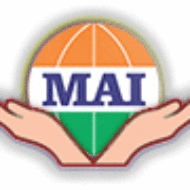
Wow, amazing blog format! How lengthy have you ever been running a blog for?
you make blogging glance easy. The overall glance of your site is fantastic, let
alone the content material! You can see similar here ecommerce